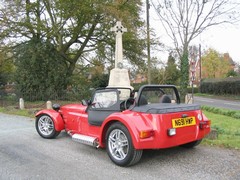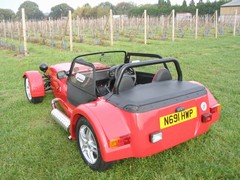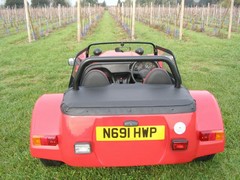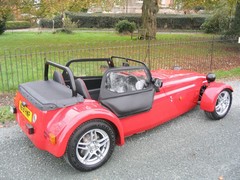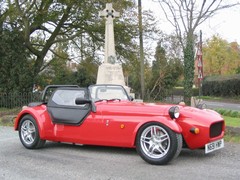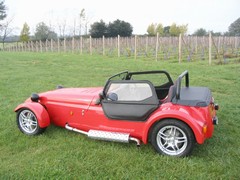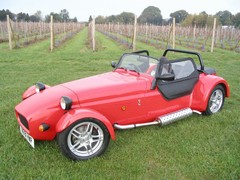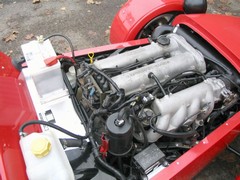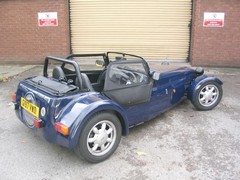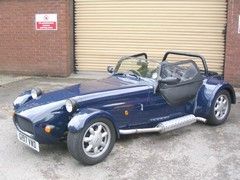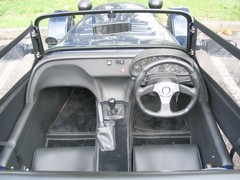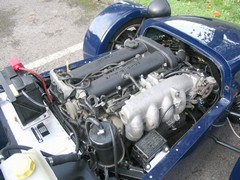Westfield Mazda SDV
Graham Bell tries a new sports car made with bits of an old sports car.
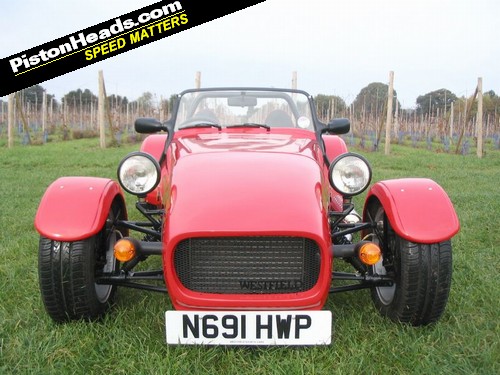
Westfield Mazda SDV
For the past 20 years or so most UK kit car manufacturers have based their front-engined rear-wheel drive single donor vehicle kits around Ford cars, initially the Mk1/2 Escort, then the Mk3/4/5 Cortina and finally the Sierra.
However, with Ford going completely front wheel drive in 1993 and even Sierras now something of a rarity, it was only a matter of time before the industry was forced to look for alternatives – not that there are many to choose from.
BMW is one obvious possibility, especially with the 3-Series being so common, but Westfield decided that the best base for its latest SDV (single donor vehicle) model was Mazda’s Mk1 MX5.
Available Mazda
Besides still being readily available, Mazda’s little roadster has always been highly rated as a driver’s car, so there’s also a sound logic in using parts originally designed for one lightweight sports car to make another lightweight sports car.
As you’ve probably guessed from the pictures, aside from the source of its mechanical parts, Westfield’s Mazda SDV is essentially the same Seven-inspired roadster it’s been making since 1986.
The most obvious visual clue to the Mazda version is the dashboard, which combines a curvy GRP panel with the MX5’s instrument pod to produce a more stylish and far cheaper alternative to the usual flat panel with aftermarket instruments.
Westfield aficionados might also notice the MX5 front uprights and hubs instead of Westfield’s usual custom alloy items, with the brakes being MX5 too rather than Ford, while at the rear the diff, driveshafts, uprights and brakes also come courtesy of Mazda.
The steering rack is Westfield’s own as fitted to its established models, though in this car it’s controlled via a Mazda steering column that affords the rare luxuries (by Westfield standards) of self-cancelling indicators and intermittent wipe.
Talking of electrical stuff, further useful savings on build costs are made by using the MX5 wiring loom, though it does require some modifications to adjust various wire lengths and remove others for electric windows etc that the Westfield doesn’t need.
Not surprisingly the chassis is essentially the same, well-proven square-tube spaceframe that Westfield has been using for some 20 years now, with just a few slight modifications to accommodate the MX5 bits.
Likewise the all-round coilover and wishbone suspension is the same as for existing models apart from minor mods to suit the Mazda bits.
1.8 is best?
Although Westfield’s initial plan was to base the car purely on the early 1600cc MX5, once it was launched people inevitably started to ask if you could build it using parts from the later 1800cc model. The short answer was no, because there were a number of differences that precluded it. However, as customer demand was obviously there, Westfield did the only logical thing and re-engineered the car so that it can be built using either version.
Something else some people who’d tried the original blue 1600 car asked for was more room under the steering wheel because, while it’s fine for average height slim types, larger drivers found it too close to their legs.
Consequently Westfield’s new red 1800 SDV demonstrator with the re-engineered chassis has the steering wheel an inch higher, and while this certainly provides more legroom it’s still not a car for the seriously large.
Westfield’s narrow high-back seats were clearly never designed for over-indulgent pie-eaters, while even with my average height I had the seat virtually back to the bulkhead, so I think anyone much over six feet tall will find it too cramped. And those who do fit still have to cope with a lack of space in the traditionally Seven-esque footwell, making narrow footwear the order of the day.
Classic bum-on-floor
The driving position is of course the classic race-car style ‘bum on floor’ job and looking through that heated screen down the long bonnet to the road ahead provides a stirring view that has you itching to fire it up and get on with it.
When Mazda was developing the MX5, it apparently went to great lengths to come up with an exhaust system that gave just the right note. Westfield by contrast simply hooked up its standard silencer to Mazda’s exhaust manifold and ended up with something that sounds better than any MX5 I’ve ever heard, the resultant deep throb sounding like it’s coming from something rather more potent than a standard spec, small capacity four pot.
Don’t know what lengths Mazda went to developing the MX5’s gearchange, but it has a beautiful short, precise throw that’s a delight to use and is perfectly suited to the sort of spirited driving a Westfield is designed for – as are the Shropshire roads not far from Westfield’s HQ.
Getting out of Birmingham (or more accurately, getting lost in Birmingham) showed that Westfield’s Mazda SDV is fuss-free and easy to drive in city traffic – apart from along some of Brum’s more appalling roads, which produced lots of jolting, rattling and banging from the front suspension.
Once finally out on Shropshire’s winding country roads it soon became obvious that the suspension has been set on the soft side to provide a comfortable ride, and for the most part it copes well with the sort of surfaces you generally find in the Westfield’s natural rural habitat.
Avoid speed humps
However, when pressing on along one particularly bumpy, undulating lane the Westy bottomed out rather noticeably, while as I discovered on the way to the photo location, if you really don’t want to hear nasty scraping noises you definitely need to avoid speed humps.
When it comes to performance, the 1800 engine obviously produces more power than the 1600 (130bhp as opposed to 118) but it also comes with a weight penalty, resulting in a kerb weight of 585kg compared to 545kg for the 1600 car.
Consequently any performance gain is likely to be negligible, and having driven both versions – albeit several weeks apart - the 1600 certainly felt just as quick on the road. Quick enough on a couple of occasions to get past a whole line of A-road dawdlers in one go by dropping it into third and revving the willing little twin cam round to the red line, and I can well believe Westfield’s claim of 0-60 in just 5.5 seconds.
Nimble handling
But it’s on quiet country lanes devoid of dawdlers and where nimble handling counts for more that brute power that cars like this really shine.
Westfield’s steering is very light and extremely responsive to driver input, which combined with those visible front mudguards makes it easy to place the front end of the car exactly where you want it.
When it comes to knocking excess speed off for a tight or blind bend the unservoed brake pedal is nicely weighted, so that while it requires quite a firm shove to make those MX5 brakes work hard it requires an extremely firm shove to lock them up.
A quick flick of that stubby gear lever will then instantly have you in a lower gear so that you can keep that revvy little twin cam on the boil through the bend, with the car’s responsive steering and agility making it easy to adjust your line if necessary.
The standard MX5 size 185/60x14 tyres seem well up to coping with the modest power and light weight, so nailing the throttle out of the bend isn’t likely to get the tail out, just accelerate you quickly towards the next bend so you can do it all again.
And you’ll be doing it with a silly grin on your face.
A lot of fun
This car really is a lot of fun, and if you fancy building one, any Mk1 ‘pop-up’ headlights MX5 from 1990 to 1998 can be used, though Westfield recommends using a pre-95 model so that you don’t have to fit a catalytic converter.
Even with cars of this age, Japanese reliability means the chances are that the mechanical parts will still have plenty of life in them as evidenced by Westfield’s demonstrators. Apart from a basic service, the engines in both cars are just as they came out of high mileage donor vehicles (120,000 for the 1600 and 90,000 for the 1800) and both are still running good as new.
In fact as far as I can see, the only disadvantage to using the MX5 as a donor vehicle is that it’s never likely to reach the ‘50 quid banger’ status of old Fords, with even the earliest versions still selling for over a grand because they’re usually still so usable.
The obvious solution is to use a damaged example, with these being available for under £500, less whatever you can get for any usable body or trim parts you don’t need.
Excellent value
With Westfield’s complete MX5 SDV kit costing £6,450 that means you could build one of these cars for under £7,000, while Westfield’s name and pedigree should guarantee a straightforward build and good resale price too.
That’s damn good value for this sort of toy – which let’s face it is essentially what this type of car is - and judging by how little the fuel gauge in the 1600 went down during my drive it should even be cheap to run.
So who needs old Sierras anyway?
© Copyright Graham Bell 2006
Gassing Station | Kit Cars | Top of Page | What's New | My Stuff

